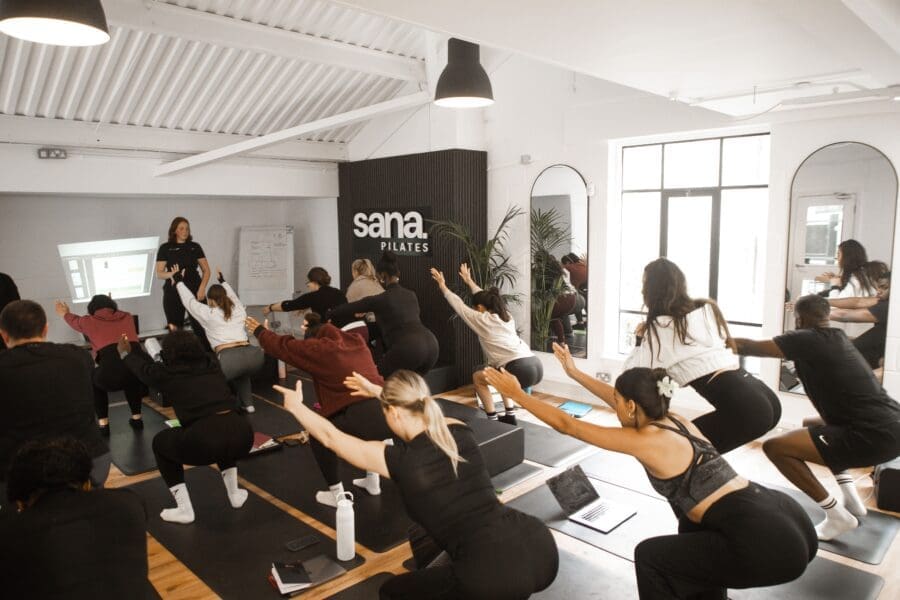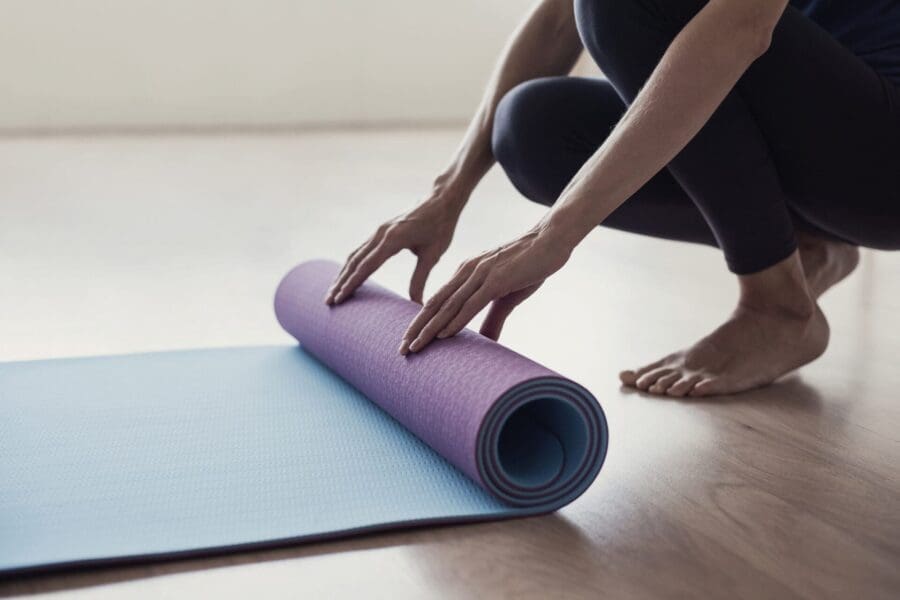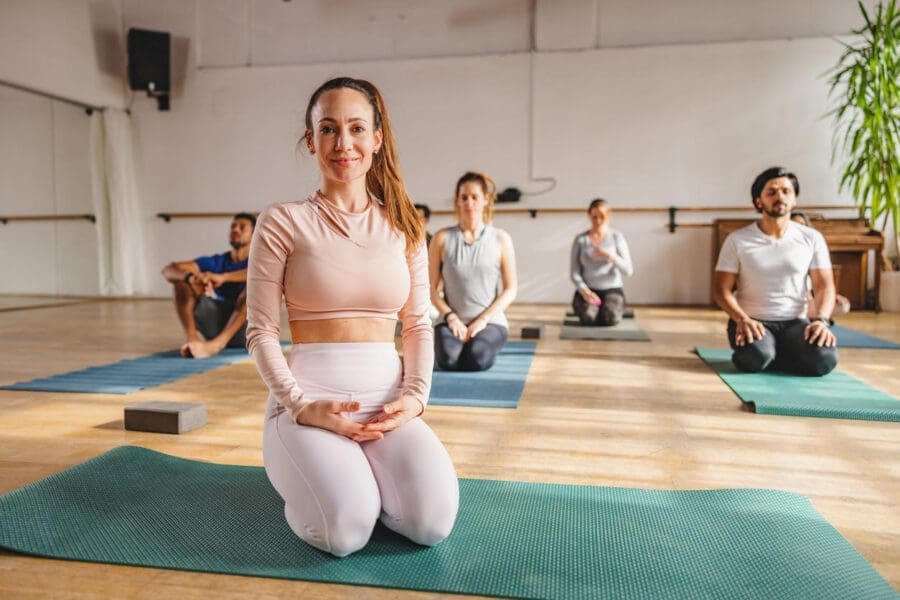Contents
What are Tempo Pilates?
Tempo Pilates blends all the classical Pilates principles. Whether it is the correct breathing, the controlled movements, the precision or flow, they’re all done with deliberately faster pacing and music-led rhythm. You can expect flowing sequences on mat or Reformer Pilates that sync with BPM, creating a low-impact, full-body session that still feels athletic. This new type of workout is trending for enhancing muscular function beyond traditional Pilates. It is driven by music and continuous movement, with Reformers and mat formats both in play.
Many studios are beginning to formalise this format. For example, Tempo sessions presented as a self-run circuit program with daily “workout routines” and 24/7 access – evidence that “tempo” is moving beyond a just a trend into a class archetype. As this is an new type of pilates, prior pilates experience is a good place to start. You can do this by taking regular classes or taking a course to teach it like our Level 3 Mat & Reformer Pilates Bundle. Either way, you’ll be well equipped to adapt to these Tempo pilates.
Why are these Pilates trending?
- It packages Pilates’ posture & core benefits in a boutique studios aesthetic, think light filled studios with music and plenty of momentum – very Gen Z & Millennial friendly.
- Music and rhythm can improve motivation and performance and may lower perceived exertion in high-intensity bouts, useful for sustained flow at a good pace.
- Reformers and rhythm together is a novelty that still honours the traditional Pilates principles while being a little flashier. Many studio’s class pages are increasingly marketing more towards “Reformer to music,” reinforcing demand, with the pre-existing audience.
Coach note: “It’s especially appealing to people who like structure and flow but want something that feels more energising than a traditional session. This can involve higher repetitions, more dynamic exercises or additional equipment ie. jumpboards. ” – Allie Ryle: Pilates Tutor and Assessor
Who can benefit from them? – Words from our Pilates instructors

Our instructors highlight three groups:
- “Pilates regulars wanting a modern twist on Pilates”. – Daisy Pearce: Pilates Tutor and Assessor – Daisy Pearce: Pilates Tutor and Assessor
- “Appeals to those who might not like ‘Traditional Pilates’ as it might be too ‘slow’ for the fast pace world”. – Daisy Pearce: Pilates Tutor and Assessor
- “Suits clients who enjoy a dynamic, music-driven workout that combines the precision of Pilates with the rhythm and energy of a fitness class”. – Jodie Myers: Pilates Tutor and Assessor
What makes Tempo so different?
- Pacing & density: shorter transitions + musical phrasing increase time-under-tension while remaining low-impact.
- Rhythm & entrainment: rhythmic cues help regulate timing & pace; in rehab and exercise science, rhythmic auditory stimulation improves movement timing and adherence.
- Hybrid stimulus: continuous sequences can elevate your heart rate similarly to steady cardio (evidence shows Pilates sessions can elicit meaningful cardiorespiratory responses, though intensity varies by format).
Why the increased pacing elevates the practice
The higher cadence can raise metabolic demand and perceived “flow,” while music (especially higher-tempo, preferred tracks) can improve power your output and reduce RPE in intervals – principles you can certainly borrow for Tempo HIIT-inspired blocks within Pilates flows.
The role of music and rhythm in Tempo Pilates workouts
Music that has intentional BPM supports consistent rep speed and transition timing; platforms now offer Reformer-specific music with BPM control and interval tools – for instructors, this standardises class quality.
How tempo improves muscle engagement
Deliberate eccentric tempos (e.g. 3-4s lowers) will increase time-under-tension and motor control – widely used in strength/Pilates coaching – and when paired with breath and precision, reinforce form under fatigue. These are General tempo-training principles that can be applied to Pilates.
Benefits of Embracing Tempo Pilates

Enhanced muscle tone and body shape
Pilates improves alignment and muscle endurance. Systematic reviews show it leads to better posture and function. These gains also improve your appearance aesthetically. After about 2 or 3 months of regular sessions your muscle tone will be much more pronounced.
Deep core activation and posture transformation
Evidence shows that Pilates improves posture and trunk control. Studies on reformer Pilates also show cognitive and neuromotor benefits in people who are sedentary. This is due to the constant mind-body engagement you need to carry out a class.
Low-impact path to high-intensity fitness and stamina
Pilates’ joint-friendly patterns can still raise Heart rate; single-session data show meaningful cardiorespiratory responses compared with brisk walking, and broader evidence supports CRF improvements across programs.
Cardiovascular health boost
While exactly not a direct replacement for vigorous cardio, consistent tempo pilates sessions will contribute to weekly exercise targets and heart health; pairing with walking/running or cycling is an effective way to ensure you reach them.
What to expect from your first Tempo Pilates class

Class formats
- Warm-up (standing mobility, breath, spinal articulation)
- Core & strength (lunges, planks, squats with tempo cues on springs/bodyweight)
- Mobility & flexibility (hip openers, thoracic rotation)
- Cool-down (parasympathetic breath work, gentle stretches)
Studios presenting tempo pilates often use circuit program logistics (stations/rounds) or music-timed flows – both appear in SERPs.
Preparing for your first class
- “We’d suggest clients wear fitted, comfortable activewear that allows freedom of movement and helps instructors check alignment easily. Grip socks are a must for safety and stability. There’s no need to bring much else – just water and an open mind!” – Jodie Meyers: Pilates Tutor and Assessor
- “Arrive early to set up and get comfortable” – Daisy Pearce
- Check the studio ventilation system (comfort matters when pacing is higher).
- Bring: “Water bottle & small towel.” – Daisy Pearce: Pilates Tutor and Assessor
- “Keep an open mind – tempo takes a class or two to get used to.” – Daisy Pearce: Pilates Tutor and Assessor
- Share any injuries with the Tempo Pilates instructor (health professional triage if needed).
- Review studio safety guidelines (spring settings, carriage control, transitions).
Tempo Pilates vs Traditional

The desired outcomes of each method
- Traditional Pilates: skill acquisition, mobility, alignment, gradual strength and mind-body awareness.
- Tempo Pilates: all of the above + rhythm-driven conditioning and denser work density (useful for clients who enjoy music and momentum).
Choosing the right style for your goals
If you prefer measured pace and meticulous technique work, start traditional; if you love music-led flow and a sweatier feel, try Tempo reformer Pilates or mat tempo blocks – both count as Tempo Pilates & many clients alternate both for a complete program.
Tempo Pilates Programming cheat-sheet for instructors
BPM blocks
- Warm-up/mobility: 60–90
- Skills/strength (controlled): 90–110
- Short conditioning flow (form-first): 100–120.
Tempo cues (examples)
- Footwork 3-0-1-0
- Side splits 2-0-2-1
- Lunges 3-1-1-0
- Plank-to-pike 2-1-2-1
- Finisher 2-0-2-0.
Safety must-dos
- Daily kit checks
- scheduled maintenance
- Publish studio rules
- Match class size to supervision
- Cue carriage control before cadence
- First-class briefing on attire, Springs & Transitions
- Clear referral pathway to a health professional when needed.
Take the first step towards teaching Tempo Pilates today
Take what you’ve learned about tempo, music, and mindful cueing, and bring it to life in your sessions. When art meets science in movement, every beat becomes an opportunity to educate, energise, and elevate the Pilates experience. Our instructor pathway covers: Level 3 Mat Pilates and Level 3 Reformer Pilates, one of which is needed before you specialise in teaching Tempo Pilates. In the Pilates world this is also known as Dynamic Pilates and the Fitness Group has these qualifications added to our course list in 2026. This will incorporate a variety of exercises that are more plyometric dynamic based, a variety of equipment including dumbells and additional Pilates apparatus such as the jumpboard. The course will be available in the UK and Dubai with blended learning.
References
- Brown, T. and Clarke, R. (2023) Pilates equipment safety: risk factors associated with apparatus use in group classes. Journal of Physical Activity and Health. Available at: https://www.sciencedirect.com/
science/article/pii/ S1360859222000699 (Accessed: 5 November 2025).
- Gonzalez, A., Patel, N. and Wong, L. (2024) Tempo training: time under tension and its relevance to hypertrophy and strength. Journal of Strength and Conditioning Research. Available at: https://www.sciencedirect.com/
science/article/pii/ S1440244023000671 (Accessed: 5 November 2025).
- Kim, H. and Lee, S. (2023) Effects of reformer Pilates training on muscle endurance and lumbar-pelvic stability in sedentary individuals. Journal of Bodywork & Movement Therapies. Available at: https://www.
bodyworkmovementtherapies.com/ article/S1360-8592%2822% 2900069-9/fulltext (Accessed: 5 November 2025).
- Oliveira, C., Martins, R. and Alves, J. (2022) Effectiveness of Pilates exercises in improving health-related outcomes in adult women: a systematic review. Sports Medicine – Open. Available at: https://bfpt.springeropen.com/
articles/10.1186/s43161-023- 00128-9 (Accessed: 5 November 2025).
- Smith, K., Chan, P. and Davies, H. (2024) The acute cardiorespiratory response of Pilates exercise: a systematic review. European Journal of Applied Physiology. Available at: https://www.sciencedirect.com/
science/article/pii/ S2590109524000351 (Accessed: 5 November 2025).
- Terry, P., Karageorghis, C. and Lane, A. (2023) Music motivates: the effects of music on physical performance and the psychological flow state. Frontiers in Psychology. Available at: https://www.frontiersin.org/
articles/10.3389/fpsyg.2023. 1138638/full (Accessed: 5 November 2025).
- Li Y, et al. 2024. Effects of Pilates on spine deformity and posture: a systematic review. BMC Sports Sci Med Rehabil. 16:55. doi:10.1186/s13102-024-00843-3.
- Wang X, et al. 2023. Effects of rhythmic auditory stimulation on motor function and balance ability in stroke: A systematic review and meta-analysis of clinical randomized controlled studies. Medicine. 102(27):e36466. doi:10.1097/MD.0000000000036466.

